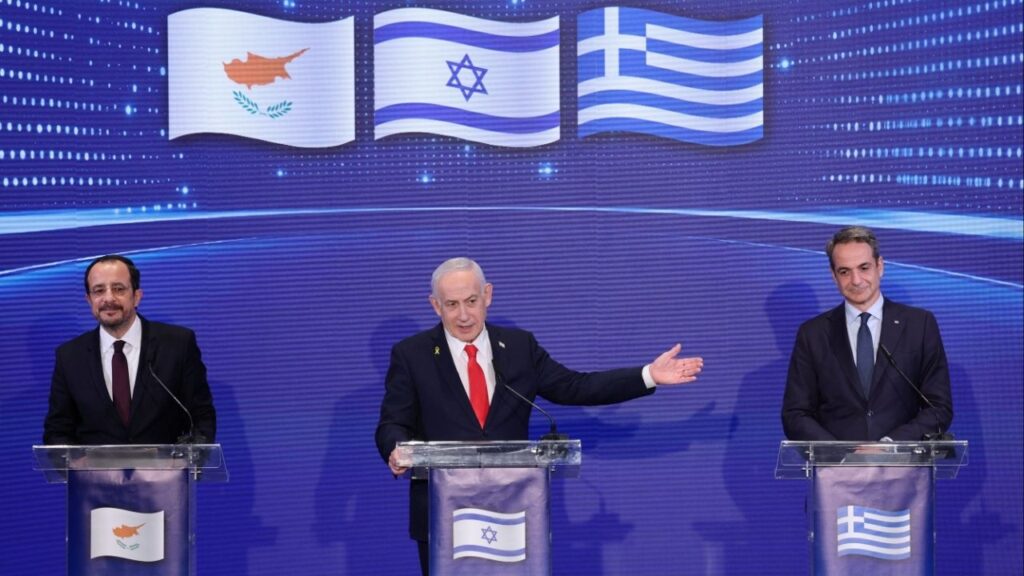The oil tanker Advantage Sweet, seized by Iran in 2023 amid US-Iran tensions, has finally reached international waters, according to tracking data. (AP Photo)

- The tanker, carrying $50 million worth of oil, was unloaded while in Iranian custody.
- Iran's seizure of the tanker was linked to a court case ordering the US to pay $6.7 billion in compensation.
- The case was related to a Swedish company halting supply of special dressings for a rare skin disorder due to US sanctions on Iran.
Share
|
Getting your Trinity Audio player ready...
|
DUBAI, United Arab Emirates — An oil tanker held by Iran for over a year after being seized amid tensions between Tehran and the United States reached international waters on Thursday, tracking data showed.
The Marshall Islands-flagged tanker Advantage Sweet traveled through the Strait of Hormuz, where it was seized in April 2023 by Iran’s navy while carrying $50 million worth of oil from Kuwait for Chevron Corp. The strait is the narrow mouth of the Persian Gulf through which 20% of the world’s oil passes.
Tracking Data and Destination
Tracking data analyzed by The Associated Press showed the Advantage Sweet had been unloaded while in Iranian custody and that the vessel listed as its destination Khor Fakkan in the United Arab Emirates, which has been the first port of call for other ships leaving Iranian detention.
Iran did not acknowledge the ship’s departure. It came after an Iranian court earlier on Thursday ordered the U.S. government to pay more than $6.7 billion in compensation over a Swedish company stopping its supply of special dressings and bandages for those afflicted by a rare skin disorder after Washington imposed sanctions on the Islamic Republic.
Related Story: Masoud Pezeshkian: From Heart Surgeon to Iran’s President
Reasons for Seizure and Court Case
Iran’s government initially said it seized the Advantage Sweet because it hit another vessel, something not supported by any evidence. Then Iranian officials linked the Advantage Sweet’s seizure to the court case decided Thursday.
The developments follow the recent election of the reformist President-elect Masoud Pezeshkian, who has vowed to improve relations with the West.
A report by the state-run IRNA news agency described the $6.7 billion order as being filed on behalf of 300 plaintiffs, including family members of victims and those physically and emotionally damaged. IRNA said about 20 patients died after the Swedish company’s decision.
Related Story: Reformist Candidate Wins Iran’s Presidential Election
Epidermolysis Bullosa and the Impact of Sanctions
Epidermolysis bullosa is a rare genetic condition that causes blisters all over the body and eyes. It can be incredibly painful and kill those afflicted. The young who suffer from the disease are known as “butterfly children” as their skin can appear as fragile as a butterfly’s wing.
The order comes as U.S. judges have issued rulings that call for billions of dollars to be paid by Iran over attacks linked to Tehran, as well as those detained by Iran and used as pawns in negotiations between the countries — something Iran has responded to with competing lawsuits accusing the U.S. of involvement in a 2017 Islamic State group attack.
The United Nations’ highest court also last year rejected Tehran’s legal bid to free up some $2 billion in Iranian Central Bank assets, frozen by U.S. authorities.
In 2018, then-President Donald Trump unilaterally withdrew the U.S. from Iran’s 2015 nuclear deal with world powers, apparently sparking the Swedish company to withdraw from the Iranian market. Iran now says it locally produces the bandages.
Chevron, based in San Ramon, California, has maintained that the Advantage Sweet was “seized under false pretenses.” It since has written off the cargo as a loss.
Related Story: Iran Holds Runoff Presidential Vote Pitting Hard-Liner Against Reformist After ...
Withdrawal from the Deal and Its Consequences
The withdrawal from the deal effectively ended an accord in which Tehran drastically limited its enrichment of uranium in exchange for the lifting of economic sanctions. It also sparked years of attacks and tensions on land and at sea.
The U.S. Navy has blamed Iran for a series of limpet mine attacks on vessels that damaged tankers in 2019, as well as for a fatal drone attack on an Israeli-linked oil tanker that killed two European crew members in 2021.
Tehran denies carrying out the attacks, but a wider shadow war between Iran and the West has played out in the region’s volatile waters. Iranian tanker seizures have been a part of it since 2019. The last major seizure came when Iran took two Greek tankers in May 2022 and held them until November of that year.
Since then, the Iranian-backed Houthi rebels of Yemen have launched a series of attacks targeting vessels in the Red Sea corridor over the Israel-Hamas war in the Gaza Strip. A new report from the U.S. military says the Houthis likely fired an Iranian-made anti-ship cruise missile at a Norwegian-flagged tanker in the Red Sea in December, an assault that now provides a public, evidence-based link between the ongoing rebel campaign against shipping and Tehran.



















